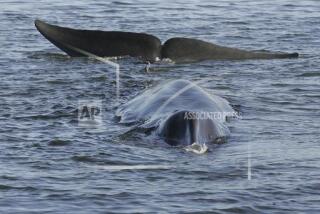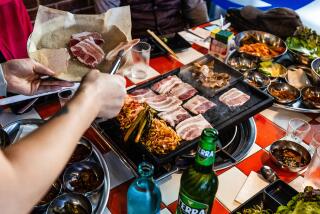Looking to Feed a Big Appetite for Whale Meat in South Korea
- Share via
ULSAN, South Korea — The whale meat can be eaten raw, as red and succulent as steak tartare, or boiled in grayish slabs that taste like pot roast.
At least 10 other cuts and preparations are on the menu at Grandma’s Whale House, one of dozens of specialty restaurants along the waterfront of South Korea’s self-proclaimed whale capital. But the challenge here isn’t in the cuisine, but in finding the whale.
Under pressure from environmentalists, South Korea joined in a worldwide moratorium on whaling in 1986. Today, the only whales that can be legally consumed are those accidentally killed in fishing nets. Before the whales are butchered, maritime police inspect the carcasses to make sure there is no sign of foul play.
“The police are very strict. Sometimes the restaurants have to close because there isn’t any whale meat,” Park Sun Ja, 61, who runs Grandma’s Whale House with her daughter and mother-in-law, complained as she leaned over a platter of whale meat slices fanned on a bed of lettuce.
But if pro-whalers have their way, whale meat might be back in abundance soon.
In a petition drive led largely by old-timers in Ulsan, many of them nostalgic for the city’s past, the South Korean government is being asked to ease the moratorium to allow the capture of 100 whales per year. Those in favor of whaling argue that a whaling revival would boost the local economy and burnish the image of an industrial city of 1.1 million where the noxious fumes of petrochemical plants drown out any whiff of sea air.
Getting into the mood, the city is opening a $6-million whale museum this month on an otherwise dilapidated wharf across from the shabby strip of whale restaurants. On an adjacent lot, groundbreaking is expected soon on a site for a whale research center, which is to include not only scientific laboratories but a processing facility for whale meat.
Ulsan is also scheduled to play host to the next annual meeting of the International Whaling Commission, the worldwide regulatory body, which will convene here in June.
Environmentalists fear that South Korea will vote with pro-whaling nations such as Japan and Norway on various measures that would weaken the moratorium on whaling.
“Things aren’t looking good for the whales,” said Jim Wickens, a 26-year-old Australian anthropologist working with Greenpeace International.
Greenpeace’s eye-catching flagship, the Rainbow Warrior, cruised into Ulsan’s harbor last month to kick off what is likely to be a months-long campaign against the whaling revival. The ship has since sailed on. But in a parking lot next to the new museum, about half a dozen activists remain camped out in a green geodesic tent surrounded by wooden whale tails in a symbolic whale cemetery.
Although there have been no clashes, there are tensions.
“Extinction starts here,” declares a banner on the Greenpeace tent, while another in Korean hung from a shabby storefront reads, “Environmentalists kill fishermen.” A South Korean fisherman set a net on fire in front of the Greenpeace tent a few weeks ago, complaining that whales consumed too much of the fish and squid that are his livelihood. (“Blaming the whales for eating the squid is like blaming woodpeckers for deforestation,” retorted Greenpeace’s Wickens. “But this whole debate is a very new thing for Koreans, so it is hard to get them to understand.”)
Despite the international moratorium on killing whales, each year about 80 minke whales are caught in South Korean waters and about 150 tons of whale meat consumed in the country, according to official statistics.
When a fisherman catches a whale in his net, he is allowed to sell it commercially after the police inspection. With whales commanding outrageous prices (restaurateur Park says one sold for $120,000 a few years ago), there is little incentive for a fisherman who finds a whale tangled in his net to cut it loose and a powerful incentive to kill one “accidentally on purpose.”
“When we hear somebody has caught a whale, it is like he has won the lottery. There is an auction for the whale meat. The TV cameras come and everybody gets all excited,” said Koo Mi Ja, a 46-year-old vendor at Ulsan’s fish market.
Environmentalists complain that the system is just a fig leaf to disguise commercial whaling.
“The Koreans make a big song and dance about how they don’t harpoon whales, but you don’t need a harpoon to kill a whale. It is very easy to drown a whale in your net,” said Wickens, noting that whales are mammals that need to surface to breathe.
He fears that the South Koreans will go one step further and adopt a policy like that of Japan, which allows about 700 whales to be killed each year, ostensibly for scientific research, although only a tiny whale sample is used for research and the bulk of the whale is sold commercially.
“All the signs are there that the South Korean government is trying to expand whaling,” said another environmentalist, Choi Ye Yong, planning director of the Korean Federation for the Environmental Movement.
The South Korean government says it has not made any decisions about changes in the laws concerning whaling. “We need more research about the quantity of whales living in Korean waters before we do anything,” said Yoon Bun Do, an official of the Ministry of Maritime Affairs and Fisheries.
Whaling here is believed to date to prehistoric times, as evidenced by a 7,000-year-old petroglyph found in Ulsan (a replica of which is in the new whaling museum) showing men pursuing whales. The practice is believed, however, to have died out until the 19th century, when European and American whalers started hunting near Korean waters.
“They [the Americans and Europeans] took their fill of whales in the past, so they can now argue for the moratorium,” Choi Dong Ik, the curator of the new museum, said as he showed a reporter around exhibits of old photographs and journals from European whalers.
Son Nam Su, a 69-year-old retired whaler, said the Japanese, during their occupation of Korea from 1910 to 1945, taught the Koreans modern whaling techniques as well as giving them a taste for whale meat. The Koreans continued whaling after the Japanese left.
“We used to catch 1,000 whales a year,” Son said. “It was a big business until the moratorium.”
Oddly enough, whale meat was not a delicacy in the early days but a source of protein for people who could not afford other red meats such as beef. It was especially useful during the Korean War, when swarms of refugees headed to the southeast coast of Korea to escape the advance of the North Korean communists.
Today, whale meat at the Ulsan fish market starts at $15 per pound and goes up to $100. Even devotees say it is not so much the meat itself that they enjoy but the way that it evokes the memories of Korea’s past.
“Whale is a nostalgic food,” said Han Jeong Ho, a 51-year-old Ulsan resident. “It reminds us of the good old days of our childhood.”
More to Read
Sign up for Essential California
The most important California stories and recommendations in your inbox every morning.
You may occasionally receive promotional content from the Los Angeles Times.










